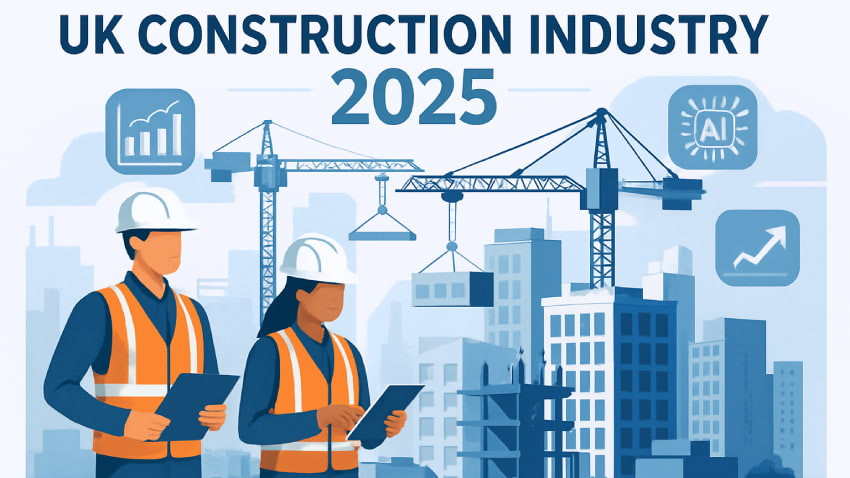As the UK construction industry steps fully into 2025, it finds itself at a critical juncture. Faced with mounting pressures from economic uncertainty, evolving regulations, and increasing demand for sustainable infrastructure, the sector is undergoing a profound transformation. Yet, amid these challenges lie opportunities for innovation, growth, and long-term resilience.
1. Economic Pressures and Project Delays
The UK construction market entered 2025 under continued financial strain. Rising material costs, inflationary pressures, and tighter credit conditions have led to delays or cancellations of several large-scale developments. Public sector projects, particularly in housing and transport, are facing scrutiny over funding availability, while private developers are adopting a more cautious approach.
Despite this, government-backed initiatives such as the National Infrastructure Strategy and increased public-private partnerships (PPPs) are helping to sustain momentum in key areas like rail expansion, digital connectivity, and urban regeneration.
2. The Rise of Modular and Offsite Construction
One of the most notable trends shaping the industry in 2025 is the growing adoption of modular construction and offsite manufacturing . As traditional methods struggle to meet demand due to labour shortages and project timelines, offsite solutions offer faster delivery, reduced waste, and improved quality control.
Prefabrication techniques are being widely used in sectors such as social housing, healthcare, and student accommodation. The UK government has also shown strong support through policy incentives and procurement preferences for modular schemes that align with sustainability goals.
3. Net-Zero and Green Building Standards
With the UK’s legally binding target of achieving net-zero carbon emissions by 2050, the construction industry is under increasing pressure to decarbonise. In 2025, sustainable building practices , energy-efficient materials, and low-carbon design principles are no longer optional—they are essential components of any major development.
New regulations such as the Future Homes Standard and Part L and F updates are driving improvements in insulation, ventilation, and energy performance. Developers are investing heavily in renewable technologies like solar panels, heat pumps, and green roofs. Retrofitting existing buildings to meet modern efficiency standards is also gaining traction, creating new demand across the sector.
4. Technology Integration and Digitalisation
Technology continues to reshape how construction projects are planned, executed, and managed. In 2025, Building Information Modelling (BIM) has become standard practice across all major projects, enabling better collaboration, cost estimation, and lifecycle management.
Other digital tools now seeing widespread adoption include:
- Drones and robotics for site surveying and hazardous tasks
- Artificial Intelligence (AI) for predictive maintenance and risk analysis
- Digital twins for real-time monitoring of structures
- Augmented Reality (AR) for on-site visualisation and training
These advancements are not only improving efficiency but also attracting a new generation of talent who seek tech-driven careers in construction-related fields.
5. Workforce Challenges and Skills Development
Labour shortages remain one of the biggest hurdles for the industry. With an aging workforce, reduced EU migration, and competition from other sectors, construction firms are struggling to fill both skilled and semi-skilled roles.
In response, there’s been a renewed focus on:
- Expanding apprenticeship programs
- Offering on-the-job training and reskilling initiatives
- Partnering with educational institutions to promote STEM subjects and vocational pathways
- Encouraging diversity and inclusion to attract underrepresented groups
The government’s Construction Sector Deal and various industry-led campaigns are working to rebrand the sector as a modern, innovative, and rewarding career choice.
6. Urban Regeneration and Smart Cities
Urban centres across the UK are embracing smart city technologies and regeneration projects aimed at revitalising town centres, improving transport systems, and enhancing living environments. From Manchester to Bristol, cities are investing in mixed-use developments that integrate residential, retail, and commercial spaces with sustainable transport links and digital infrastructure.
These efforts are supported by regional growth funds and local authorities aiming to boost post-pandemic economic recovery while addressing housing shortages and environmental concerns.
7. Health, Safety, and Mental Wellbeing
Health and safety have always been a priority in construction, but in 2025, there’s a broader recognition of the importance of mental wellbeing and workplace culture . Employers are increasingly implementing mental health first aiders, flexible working arrangements, and wellness programs to support their teams.
The industry is also benefiting from greater awareness and reporting mechanisms for issues like stress, fatigue, and workplace bullying—helping create safer, more inclusive environments.
8. Supply Chain Resilience and Procurement Shifts
Global supply chain disruptions have forced construction firms to rethink procurement strategies. In 2025, there’s a stronger emphasis on sourcing materials locally, diversifying suppliers, and using alternative products to mitigate risks.
This shift is also aligned with sustainability goals, as companies aim to reduce transportation emissions and support domestic industries.
Conclusion: A Transformative Year Ahead
The UK construction industry in 2025 is navigating a complex landscape of economic, technological, and environmental change. While challenges such as workforce shortages and rising costs persist, the sector is responding with innovation, adaptability, and a commitment to long-term sustainability.
Those who embrace digital transformation, invest in people and skills, and align with national climate goals will be best positioned to thrive in the years ahead. As the foundation of the nation’s infrastructure, housing, and economy, the construction industry remains vital—and its evolution in 2025 will shape the future of the UK built environment.








